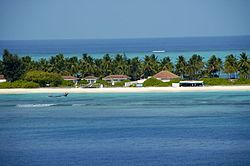
Back लक्षद्वीप ANP لكشديب Arabic লাক্ষাদ্বীপ Assamese Lakshadweep AST लक्षद्वीप AWA لاکشادویپ AZB Лакшадвіп Byelorussian Лакшадвип Bulgarian लक्षदीप Bihari লাক্ষাদ্বীপ Bengali/Bangla
Lakshadweep | |
|---|---|
|
Clockwise from top: Kadmat Island; Minicoy Island; airport on Agatti Island; Reefs in Laccadive Sea;and Kalpeni Island | |
 Location of Lakshadweep in India | |
| Coordinates: 10°34′N 72°38′E / 10.57°N 72.64°E | |
| Country | |
| Region | South India |
| Formation | 1 November 1956 |
| Capital | Kavaratti |
| Largest city | Andrott |
| Government | |
| • Body | Government of Lakshadweep |
| • Administrator | Praful Khoda Patel[1] |
| National Parliament | Parliament of India |
| • Lok Sabha | 1 seat |
| High Court | Kerala High Court |
| Area | |
| • Total | 32.62 km2 (12.59 sq mi) |
| • Rank | 36th |
| Population (2011)[3] | |
| • Total | 64,473 |
| • Density | 1,976/km2 (5,120/sq mi) |
| Language | |
| • Official | English[4] |
| Time zone | UTC+05:30 (IST) |
| ISO 3166 code | IN-LD |
| Vehicle registration | LD |
| HDI (2019) | 0.751 (4th) |
| Literacy (2011) | 91.85% |
| Sex ratio (2011) | 946♀/1000 ♂ (1st) |
| Website | lakshadweep |
| Symbols of Lakshadweep | |
 | |
| Bird | Sooty tern |
| Flower | Neelakurinji |
| Mammal | Butterfly fish[a] |
| Tree | Bread fruit |
| List of union territory symbols | |
Lakshadweep (Malayalam: [lɐkʂɐd̪βʷiːbɨ̆]) is a union territory of India. It is an archipelago of 36 islands[b] divided into three island subgroups: the Amindivi Islands in the north, the Laccadive Islands (separated from Amindivi roughly by the 11th parallel north), and the atoll of Minicoy to the south of the Nine Degree Channel. The islands are located between the Arabian Sea to the west and the Laccadive Sea to the east, about 220–440 km (140–270 mi) off the Malabar Coast of mainland India.
The islands occupy a total land area of approximately 32.62 km2 (12.59 sq mi) with a population of 64,473 as per the 2011 census across the ten inhabited islands. There is a 132 km (82 mi) long coastline with a lagoon area of 4,200 km2 (1,600 sq mi), territorial waters of 20,000 km2 (7,700 sq mi) and an exclusive economic zone of 400,000 km2 (150,000 sq mi). Lakshadweep is the northernmost island group of the exposed undersea mountain range, the Chagos-Lakshadweep Ridge. The entire union territory is administered as a single district with Kavaratti as its capital.
Archaeological evidence from Kalpeni indicates human settlement in the region from at least 1500 BCE with early reference to the islands in the Buddhist Jataka tales from the 3rd century BCE and the Tamil Sangam literature Patiṟṟuppattu. The region was controlled by the Cheras in the Sangam period (3rd century BCE to 3rd century CE) and later by the Pallavas. Islam is presumed to have been brought in the 7th century by the arrival of Muslims. In the 11th century CE, the region was under influence of the Chola kingdom and formed a part of the trade route that connected the Middle East with South Asia. It came under the influence of the Portuguese briefly in the late 15th century CE before being ruled by the Arakkal kingdom, who were vassals of the Kolathiri Rajas of Kannur. The region was under the influence of the Mysore kingdom in the late 18th century and was later annexed to the British empire in 1799 CE. The islands became part of the Dominion of India following the Indian Independence in 1947 and was incorporated as a union territory in 1956.
The name Lakshadweep means "one lakh islands" (Lakṣadvīpa; one hundred thousand islands) in Malayalam and Sanskrit, though the islands are part of an archipelago of fewer islands. English is the designated official language while Jeseri, a dialect of Malayalam, is the widely spoken native language. Dhivehi is the most spoken language in the Minicoy Island. The region comes under the judicial jurisdiction of the Kerala High Court. Fishing and agriculture are the major occupations in the islands.
- ^ "Who's Who, Lakshadweep". Government of India. 26 May 2021. Archived from the original on 30 October 2020. Retrieved 9 December 2020.
- ^ Socio-economic statistics (PDF) (Report). Government of India. Archived (PDF) from the original on 20 September 2018. Retrieved 1 January 2019.
- ^ State-wise population (Report). Government of India. Archived from the original on 29 January 2024. Retrieved 1 January 2024.
- ^ 52nd Report of the Commissioner for Linguistic Minorities in India (PDF). Government of India (Report). 9 August 2021. p. 124. Archived from the original (PDF) on 7 August 2023. Retrieved 6 November 2021.
- ^ "Uninhabited Lakshadweep island Parali I vanishes, 4 others shrinking fast". Live Mint. 6 September 2017. Archived from the original on 18 June 2021. Retrieved 16 January 2024.
- ^ Cite error: The named reference
LDwas invoked but never defined (see the help page).
Cite error: There are <ref group=lower-alpha> tags or {{efn}} templates on this page, but the references will not show without a {{reflist|group=lower-alpha}} template or {{notelist}} template (see the help page).





